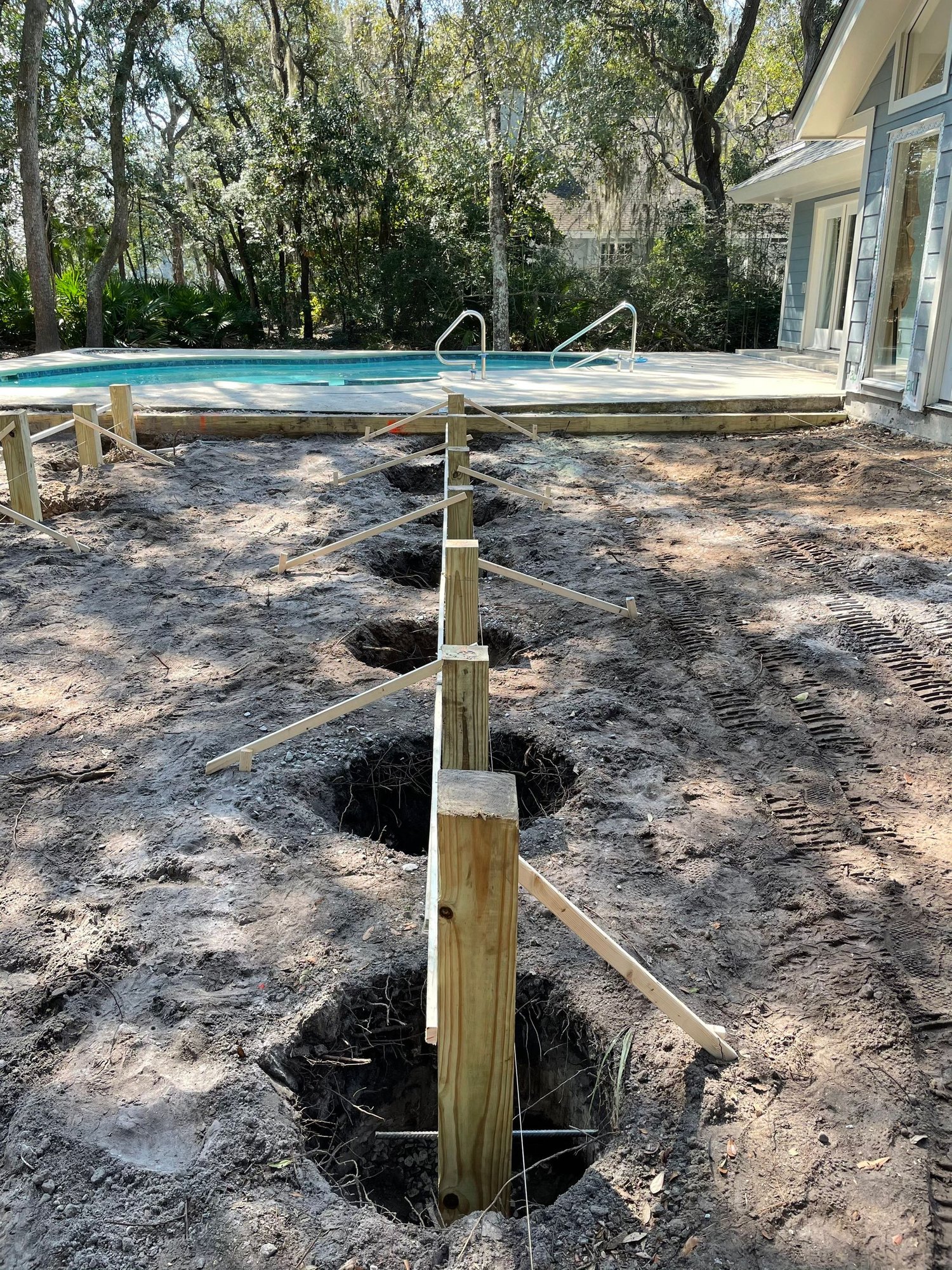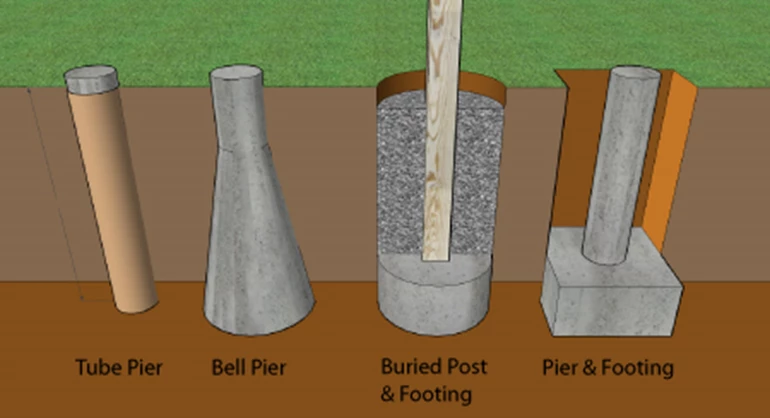Deck Footings Introduced: Comprehending the Secret Components of a Reputable Deck Structure
Deck Footings Introduced: Comprehending the Secret Components of a Reputable Deck Structure
Blog Article
Specialist Tips for Installing Deck Footings to Support Your Outdoor Room
When it comes to developing a deck, one of the most crucial aspects to take into consideration is the installment of appropriate footings. These grounds are the structure upon which your outside room will relax, providing stability and assistance for years to come. What specifically does it take to install deck footings appropriately?
Relevance of Correct Deck Footings
Correct deck grounds are important for making certain the stability and durability of your exterior area. When building a deck, it is vital to pay attention to the foundation on which it will rest. Deck footings supply the needed assistance for the whole structure and assistance disperse the weight evenly - Deck Footings. Without strong and correctly installed grounds, your deck might end up being unsteady, resulting in safety and security risks and pricey repair services.

Along with stability, proper deck footings likewise add to the durability of your outside area (Deck Footings). Footings that are designed and created to hold up against the elements and soil problems in your location will assist protect against the deck from shifting or resolving with time. By ensuring the grounds are correctly sized and mounted, you can reduce the danger of damages to the deck framework, expanding its lifespan and reducing the demand for pricey repair work or substitutes
Selecting the Right Sort Of Footings
When choosing the appropriate kind of grounds for your deck, it is crucial to consider variables such as soil problems, local building ordinance, and the overall design of your outside room. The sort of footing you pick will play an important function in ensuring the security and durability of your deck.
One usual kind of ground is the concrete footing. Concrete footings appropriate for the majority of soil conditions and provide excellent support for decks. They are usually installed below the frost line to stop changing and resolving because of freezing and thawing cycles. An additional choice is helical piers, which are excellent for areas with unstable soil or high water tables. These piers are screwed into the ground and give solid assistance for the deck.
In some instances, you might need to utilize specific grounds, such as pile grounds or deep foundations, if you are constructing a multi-level or huge deck. These grounds are made to distribute the weight of the deck over a larger area, making certain stability and avoiding clearing up or sinking.
Before choosing a type of footing, it is necessary to consult local building ordinance and laws to ensure conformity. In addition, think about the style and planned use your exterior space. Aspects such as the size, form, and load-bearing demands of your deck will certainly affect the sort of footing that is most ideal.
Preparing the Ground for Footing Installation
To appropriately prepare the ground for footing setup, it is vital to evaluate the dirt conditions and take needed steps to make sure stability and longevity of the deck. The very first step is to dig deep into the area where the footings will be mounted.
When the area has actually been dug deep into, the next action is to small the soil. This can be done utilizing a plate compactor or by utilizing a hand tamper. Compacting the soil assists to get rid of any kind of gaps or air pockets, which can bring about clearing up and instability over time.
After compacting the dirt, it is necessary to lay a layer of gravel or smashed rock at the end of the excavation. This will certainly give water drainage and aid to protect against water from merging around the grounds, which can lead to erosion and instability.
Step-by-Step Overview to Setting Up Deck Footings
After effectively preparing the ground for footing installment, the following step is to begin the procedure of installing deck grounds. This step-by-step guide will certainly give you with a clear understanding of just how to set up deck grounds for your outdoor space.
Determine the location: Begin by marking the settings of the deck footings utilizing risks and string. Make certain that the locations straighten with the layout and design of your deck.
Dig the holes: Make use of an article hole digger or an auger to dig the openings for the grounds. The depth and size of the openings need to remain in accordance with regional building ordinance and the specific demands of your deck design.
Degree the holes: Use a degree to ensure that the openings are dug to the correct depth and are level with each other. (Deck Footings)
Add gravel: Place a layer of gravel at the end of each opening to enhance drain and prevent the wood from deteriorating.
Put the footings: Position the footings into the holes, ensuring they are level and plumb. Use a level and a measuring tape to this link make certain precision.
Safeguard the footings: Put concrete right into the openings around the grounds, loading them to the top. Make use of a post level to ensure the footings stay level as the concrete collections.
Enable time for treating: Allow the concrete remedy according to the manufacturer's directions before waging the deck construction.
Common Errors to Avoid Throughout Footing Installation
One important aspect to think about during the setup of deck grounds is avoiding typical errors that can jeopardize the stability and durability of your outdoor room. While deck footings might seem like a simple and simple part of the building procedure, ignoring certain elements can cause expensive repairs and possible safety threats down the line.

Additionally, overlooking to install appropriate water drainage actions can cause water to accumulate around the footings, causing rot, degeneration, and the go to this site eventual weakening of the deck's foundation. In addition, using the wrong sort of footing material or stopping working to sufficiently safeguard the footings can jeopardize their structural stability.
To prevent these blunders, it is vital to consult with an expert or adhere to sector guidelines to ensure correct footing installation. By doing so, you can guarantee the security and longevity of your outdoor area, supplying a satisfying and safe environment for years to find.
Conclusion
In final thought, installing correct deck grounds is crucial for the security and durability of your exterior area. By choosing the ideal kind of grounds and properly preparing the ground, you can make sure a solid structure for your deck. Adhering to a step-by-step overview and staying clear of usual blunders during footing installment will better boost the resilience and safety and security of your deck.
Proper deck grounds are important for guaranteeing the security and long life of your outdoor area. The footings offer as a link in between the my sources ground and the deck, enabling the weight of the deck and its residents to be spread equally into the dirt.One common kind of footing is the concrete ground. Place the grounds: Place the footings right into the holes, making sure they are degree and plumb. Secure the grounds: Pour concrete into the openings around the grounds, loading them to the top.
Report this page